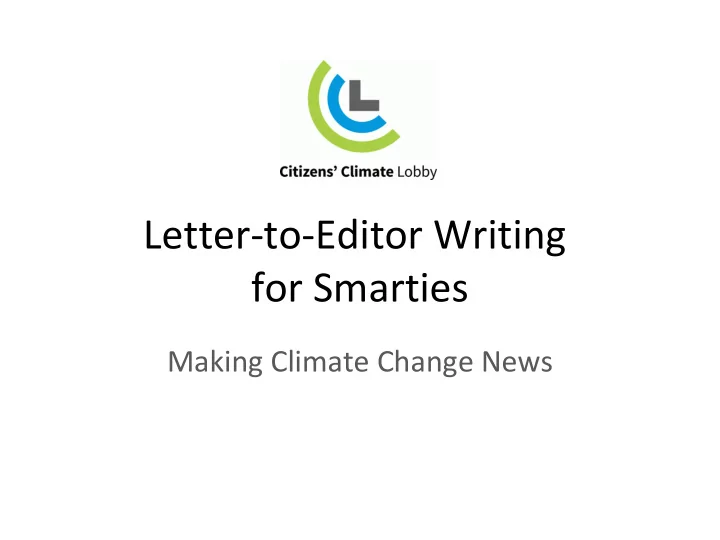

Letter-to-Editor Writing for Smarties Making Climate Change News
Why Letters to the Editor? • The Letters page is one of the most popular sections in the paper. • Politicians and their staff tend to read the letters to gauge their constituents on the news of the day. • It’s a relatively easy way to get your views published.
The Hierarchy of Letter-to-the-Editor Opportunities 1. Editorials. This is the official stand the newspaper takes on an issue. Letters responding to editorials will usually be given top priority. 2. Front page stories. These are the big stories of the day. If the newspaper decides it’s important enough to put on their front page, chances are they’ll consider letters about those stories important enough to run on their editorial pages. 3. Staff-written columns. These are columns that appear on the editorial pages that are written by editorial staffers. They provide the “branding” for the newspaper’s readership. Letters responding to staff columnists help to promote that brand and that readership.
The Hierarchy of Letter-to-the-Editor Opportunities 4 . Locally-written op-eds. These are opinion pieces written by people in the community. These pieces usually initiate a public conversation about an issue of importance to the community. A letter to the editor continues that conversation. 5. Other letters to the editor. You can respond to someone else’s letter. You’re starting to scrape the barrel at this point, but if it’s an outrageous letter that cries out for a response, it might be considered.
Philosophy about letters to the editor that get published • Reference the article. Letters that do not reference an article in the paper stand little chance of being published. • Reference the news. With a big news story — a massive extreme weather event, for instance — you might not need to cite the specific article, but you do need to reference the news. • Be creative. Climate change may not be mentioned in a story (i.e. The Franklin discovery in the Arctic) , but you can remind readers that is part of the story. • Challenge the editor. Call out important climate stories relegated to the back pages.
How to get published and influence people • Letters to the editor typically are 150-200 words, meaning you are limited to 3 or 4 short paragraphs. They are the haiku of advocacy — short and sweet. • Start the writing process by asking yourself the question: What is my message and how does that relate to the article that was in the paper?
How to get published and influence people • Opening: In your very first sentence, cite the article to which you are responding. • For example, “Your editorial Saturday questioning the existence of climate change left me quite puzzled, given that the world’s glaciers are receding at record rates.” (Note: It’s okay to challenge a view, but never be disrespectful or snide)
How to get published and influence people • Transition to message: You don’t have much space, so transition quickly to your message. • Start by stating the problem. “If we ignore what scientists are telling us, global temperatures will rise throughout the century with dire consequences — coastal flooding, droughts, famine, extinction of species.”
How to get published and influence people • Propose a solution: This is the meat of your message. • “We must reduce the level of carbon-dioxide — the primary greenhouse gas — to a level that will avert these disastrous effects. Scientists tell us that level is 350 parts per million in the atmosphere. The most efficient and effective means to do this is to place a fee on carbon and return the revenue equally to all residents.”
How to get published and influence people • Closing the letter: Finish up strong either by referring back to the beginning of the letter (closing the circle) or with something clever. • “Policy-makers can argue all they want, but Mother Nature doesn’t argue — and she doesn’t negotiate.”
How to get published and influence people • Don’t try to say everything in one letter. There’s no room f or it and it muddies the message. • In addition to your full name, the newspaper will want your address and phone number (not for publication) to verify your letter.
Go Forth & Get Published! Good Luck!
Recommend
More recommend